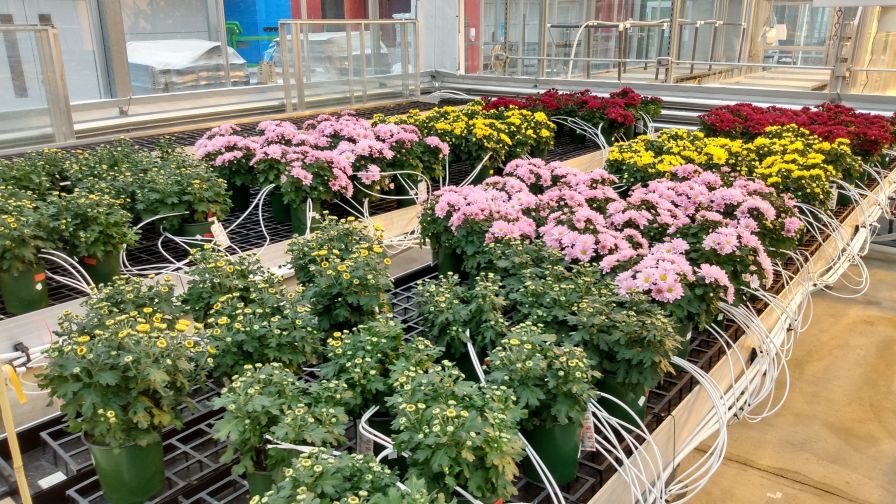
Four chrysanthemum varieties growing side by side | Jessie deHaan
Growers are particularly concerned this season regarding chrysanthemums and the flower’s risk of acting as a host for Thrips parvispinus. Many strategies are being brainstormed, especially those that can be used for the prevention of the pest AND without the panicked use of pesticides that could destroy any biocontrol program you have in place for curtailing native species. From ONfloriculture, here are some available avenues and alternatives to consider and pursue.
Cutting Dips for Thrip Thwarting
The main concern of invasive thrips primarily comes from tropical and foliage plants received from Florida, such as chrysanthemums. However, the tested tactic of cutting dips is recommended, with several incorporated products now registered in the U.S., according to the 2024 Greenhouse Insect Pest Management guide from MSU Extension.
The technique of cutting dips employs the use of reduced-risk pesticide products (microbial insecticides, oils, and soaps, depending on compatibility with the plant) to essentially smother and wash out thrips when they emerge, drastically reducing incoming populations within the crop. Its use has been shown to be effective against native thrips, reducing arriving populations and giving the biological control agents of natural enemies additional time to spread and build up a defense network among the plants.
The Best Way to Dip Cuttings
For growers who do incorporate the practice of cutting dips into their routine, there are certain best practices to emulate.
For starters, the Vineland Research and Innovation Centre and OMAFRA (Ontario Ministry of Agriculture, Food, and Rural Affairs) released a series of “How To” videos about greenhouse integrated pest management (IPM), which includes the practice of cutting dips.
Regarding label registrations to determine what products are safe to use on certain plant varieties, as well as which ones are more suitable for particular pests, the previously mentioned 2024 Greenhouse Insect Pest Management guide goes over dip registrations for growers in the U.S., while ONfloriculture’s article covers the basics for Canadian growers.
Consistent Monitoring and Pest Management Protocol
However, while cutting dips can help reduce the population of incoming thrips, it isn’t the be-all and end-all solution to your pest problem. Additional yet strategic and precise applications of bioinsecticides and pesticides are a good choice for the cautious grower.
As previously stated, the wanton use of conventional pesticides is discouraged due to their tendency to disrupt other active biocontrol programs for other types of pests. So, what products can be used, and in what way?
One example uncovered is due to investigations by Plant Products and OMAFRA, which have shown Lalguard M52 OD to be a very effective microbial product against Thrips parvispinus. Additionally, M52 is also compatible with programs for western thrips control. This product can be applied through a misting bench or a second dip of cuttings.
Still, no matter your approach and choice of products, it’s still vital to continue proper monitoring of your crops and plants. You should know what signs to look for that show the start or proliferation of Thrips parvispinus. From there, you should also have a plan in place on how to proceed if the signs emerge and regarding the relative population level of the pest upon your recognition of their presence.
For additional details on Thrips parvispinus prevention in chrysanthemums, please read the original article from ONfloricutlure, which supplements the aforementioned points and advice with videos, graphs, and expert testimony.

